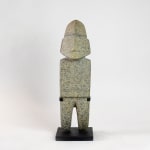Mezcala Idol, 300 BC - AD 300
Andesite
44.5 x 12.1 x 10.2 cm
17 1/2 x 4 3/4 x 4 in
17 1/2 x 4 3/4 x 4 in
CK.0826
Further images
Along the region of the Rio Mezcala in the Central portion of the Mexican state of Guerrero, an ancient culture evolved which created highly expressive and powerful stone ritual objects....
Along the region of the Rio Mezcala in the Central portion of the Mexican state of Guerrero, an ancient culture evolved which created highly expressive and powerful stone ritual objects. Possibly springing from the same roots as the famous Olmec culture, the people of Mezcala imbued Celts, axes used for hafting, with both magical and spiritual symbolism. The talented Mezcala artists who created these dynamic ritual Celts developed a powerful, expressive style of abstraction remarkably close to that of many modern artists.
This sculpture exudes a force of the ages. It has witnessed the passage of seasons and the passage of civilizations. Today it stands as the reminder of a forgotten era. However, superstition still pervades our modern society and our understanding of the universe and science still cannot provide the answers we long for. God is still the great unknown, be it scientific or religious. God will always exist at the limits of our comprehension of life and the universe. Like a miniature idol from Easter Island, this stone figure stands with open legs, arms held to the sides, and protruding jaw and forehead. If inverted, the figure transforms into the head of a jaguar, the sacred beast of the jungles of Mexico, much like shamans were thought to transmogrify into wild animals. The open legs become ears and the figure’s face becomes the feline’s muzzle. Meanwhile, the actual contours of the statue also echo the form of a phallus. Most likely, this statue would have been used as a pestle to grind up corn or wheat. Thus as the women of the tribe prepared the food, they would have held in their hands the symbol of male fertility, linking the immediate survival of the community through food with the procreation of the species through copulation. All at the same time invoking the favors of the gods. The power present in this statue is as real today as it was in ancient times. The vital components of life never change. This image of fertility, of nourishment, of the divine, is as relevant to our reality as it was to those who carved it.
This sculpture exudes a force of the ages. It has witnessed the passage of seasons and the passage of civilizations. Today it stands as the reminder of a forgotten era. However, superstition still pervades our modern society and our understanding of the universe and science still cannot provide the answers we long for. God is still the great unknown, be it scientific or religious. God will always exist at the limits of our comprehension of life and the universe. Like a miniature idol from Easter Island, this stone figure stands with open legs, arms held to the sides, and protruding jaw and forehead. If inverted, the figure transforms into the head of a jaguar, the sacred beast of the jungles of Mexico, much like shamans were thought to transmogrify into wild animals. The open legs become ears and the figure’s face becomes the feline’s muzzle. Meanwhile, the actual contours of the statue also echo the form of a phallus. Most likely, this statue would have been used as a pestle to grind up corn or wheat. Thus as the women of the tribe prepared the food, they would have held in their hands the symbol of male fertility, linking the immediate survival of the community through food with the procreation of the species through copulation. All at the same time invoking the favors of the gods. The power present in this statue is as real today as it was in ancient times. The vital components of life never change. This image of fertility, of nourishment, of the divine, is as relevant to our reality as it was to those who carved it.









